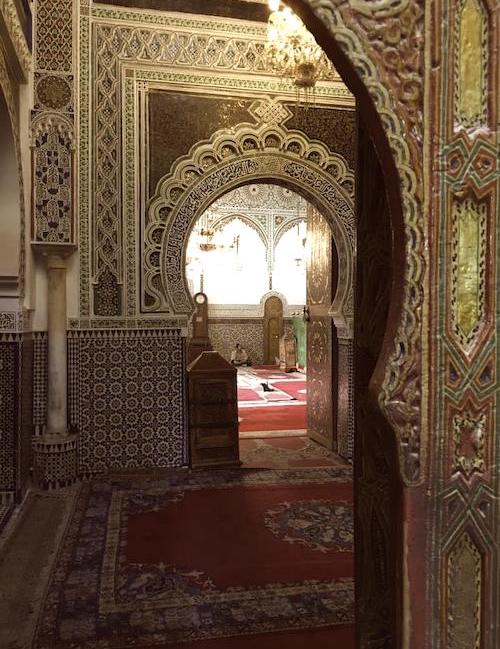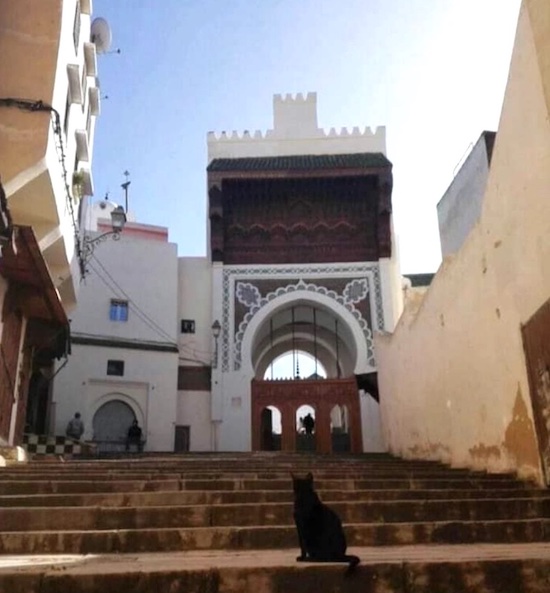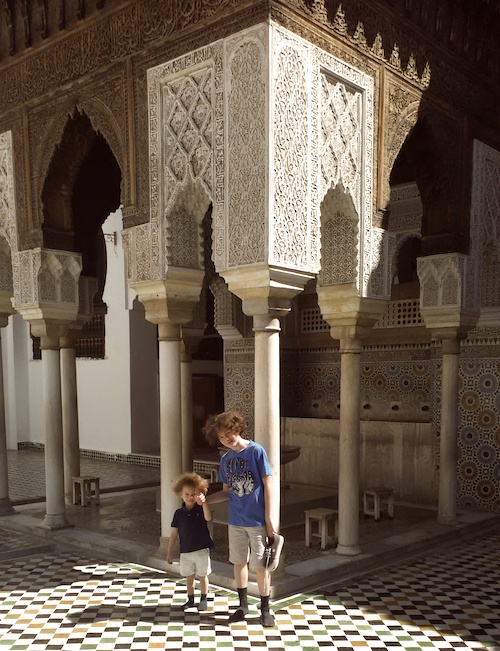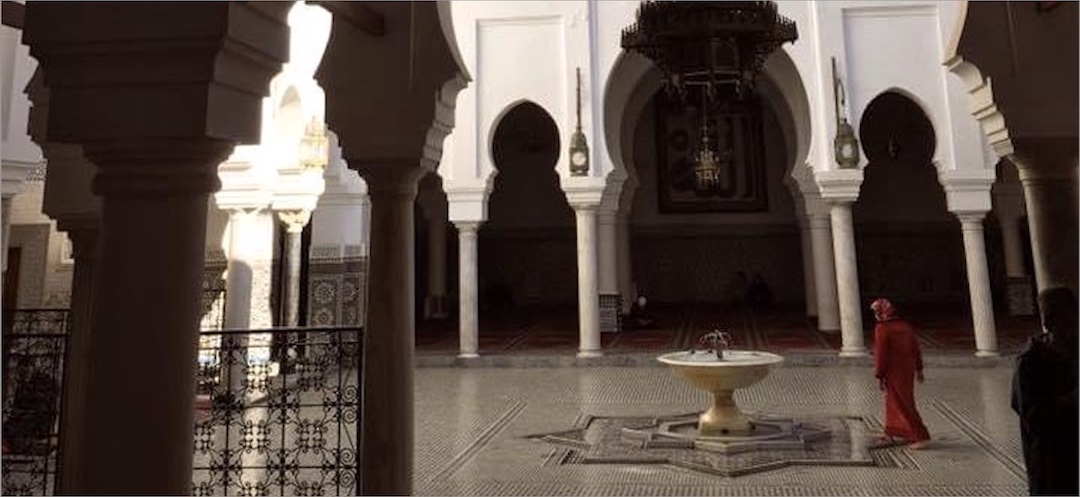The ancient city of Fez is host to more than 300 mosques and medersas – Religious universities teaching theology.
As non-Muslims are not permitted to enter mosques, the best you can do is try and catch a glimpse of the interiors – which, in Fez, are always spectacular – through one of the many entrance doors.
Yet walking around the building from the outside is also interesting as there are quite nice architectural features.
Exploring Fez mosques is a total immersion in the faith of the sherifian Kingdom.
In a few lines I will try to introduce you to the main mosques of fez that I had the privilege of visit.
ZAOUIA MOULAY IDRISS, A SPECIAL FEZ MOSQUE
My favourite mosque, although most muslims would not call it a mosque, is the Zaouia Moulay Idriss. It is host of the mausoleum of Moulay Idriss II, son of the founder of Fez and its holly leader.
Zaouia Moulay Idriss is one of Morocco’s most popular pilgrimage destinations.
I like everything there. From the colorful zelliges (traditional Moroccan mosaics), the thinly carved plaster work and the brightness of the red carpets.
The Saint’s tomb stands in the middle of the room located directly at the main entrance door. It is often surrounded by devotees bearing incense and candles.

All this ritual and staging make it a place where the most fervent Sunni worshippers would not want to pray. In fact, Sunni Islam does not have Saints and would not erect a mosque in anyone’s memory.
Yet, I like the smell of candels and this somehow mystical atmosphere that reminds me of catholic churches.
MOSQUE OF THE ANDALOUS
The Mosque of the Andalous is located on the right bank of the wadi of Fez, next to the Sahrij Medersa.
It bears the name of the Andalusian families, driven out of Cordoba by the Umayyads who founded the Andalusian neighbourhood in 818.

Erected in 859-860 under the Idrisid dynasty by a woman from Kairouan, Mariyam al Fihriya, sister of Fatima al Fihriya, founder of the Karaouiyine mosque, the building, modest at first only served as an oratory. Gradually, over the centuries, it become a mosque. The Marinid dynasty added the fountain that can be seen today in the inner courtyard, as well as a library.
Later renovated by Moulay Ismaïl under the Alawites dynasty, the place, is still in use.
KARAOUIYINE MOSQUE : MOST FASCINATING FEZ MOSQUE
If you are preparing a trip to Fez, you have necessarily read about Fez mosques and especially about the Karaouiyine.
History of the Karaouiyine, the most famous of Fez mosques
The Karaouiyine is the most ancient mosque in Fez. It is part of a global cultural project offering, mosque, university and library.
Fatima Al-Fihria, a wealthy heiress from Kairouan in Tunisia, dedicated her inheritance to the worshippers of the city of Fez and initiated the project during the 9th century.
In the 12th century, the Almoravid rulers expanded the Karaouiyine to make it the largest mosque in Africa, accommodating 20,000 worshippers, and so it remained, until the construction of the Hassan II Mosque in Casablanca in the 80’s.
The Karaouiyine mosque has 270 columns divided in 16 naves of 21 arch each. It also displays no less than 17 doors, the most iconic being: the main door, «Bab Chemmâine» (door of the candle makers), «Bab El Houfat» (door of the naked feet), and «Bab El Ward» (door of roses).

My memory of my visit at the karaouiyine mosque
I must confess my first contact with the Karaouiyine, 15 years ago, was more kind of a comedy play than an encounter with spirituality.
Yet I remember how impressed I have been by the size of the mosque.
More familiar with the sumptuous mosques of Cairo sparkling with marble and gilding, I found the interior of the Karaoouiyine very modest. However, the courtyard is sumptuous. Also, the zelliges of the fountain dedicated to ablutions are exceptionally beautiful.
RELATING MY EXPERIENCES AT FEZ MOSQUES IN MY DIARY
There is no picture of my exploration of the Karaouiyine mosque, although it would have been worth a video…
In 2008, as I was on a trip in Fez with my husband, Moulay, for the follow up of Mayfez’ restoration work, I wrote in my diary:
“Today Moulay decided to visit the Zaouia Moulay Idriss and the Karouiyine. In other words, we are on our way to a spiritual visit of the medina. I am a bit stressed. I grew up in Morocco and I know that non-Muslims are not welcome in mosques… Moulay reassures me: «you are the wife of a «sherif», the mother of a «sherif», you will enter the mosques, there is no doubt about it.
I did not argue, and put on an appropriate outfit: trousers and mid- thigh linen shirt, slipped in my handbag an Hermes scarf, and off we go…
Visiting Zaouia Moulay Idriss, one of the most popular Fez mosques
The door keeper, straight away prevents us from passing the door: “it is forbidden to non-Muslims to enter the mosque”. Moulay says a few words in Arabic and seconds later we were inside, after the guard’s deepest apologies.
I tie my scarf around my hair, and we both enter the Zaouia through the women’s door. Apparently without shocking anyone. A very beautiful young Moroccan lady with a nearly see-through blouse and a white pair of jeans, displaying long braid and obviously no scarf to hide her hair, followed us inside… Zaouia Moulay Idriss is definitely a quite unusual welcoming place.
The friendly door keeper led us through a complete visit. From the areas opened to the public, to the most remote rooms. Leading a « sherif mekka » (a descendant of Prophete Mohamed), was clearly an honor for the Zaouia’s door keeper, although I suspect a few Dirhams helped convincing him.
There is no doubt the inside architectural details are beautifully crafted. Yet, I straight away liked the atmosphere of the Zaouia. The place is both peaceful and relaxing.
We leave Moulay Idriss. I take off my scarf. As we make our way from Moulay Idriss to the nearby Karaouiyine, we walk pass various fabric shops, ready-to-wear men djellabas stalls and ready to wear caftan shops for women.
Nearing the Karaouiyine we cross men pushing huge colourful nougat trolleys. Piles of enormous chunks of white, pink, blue, green nougat. They are on their way to the mosque, where they park along the mosque’s walls to sell their products.
Fez mosques : my arrival at Karaouiyine…
As expected, the door keeper denies me entry. Yet this time, with quite an unfriendly tone.
Moulay needs to argue much longer than at the Zaouia, before reaching a compromise…
I will be allowed entry at the condition that I dress in a djellaba… But I do not have a djellaba! Never mind… The Karaouiyine is a few steps away from the djelabba stalls… I will be able to rent a djellaba there. Precisely, the Karaouiyine door keeper’s cousin has a shop there…
The djellaba renter
So, here we go again. Up along the arcaded alley off Tala’a Kebira, then left in the kissaria, the large, covered and rather modern-looking souk selling fabrics and traditional clothing. Embedded caftans, embroidered mdama (large Moroccan traditional belts), babouches, colourful silk threads, this is heaven to any Moroccan fashionista. Yet no simple, modest djellaba are to be seen.
Moulay asks a shopkeeper. He giggles, answering that djellabas are not near here. Yet “machi moushkil” (no problem), he often rents caftans to enter the Karaouiyine. I must confess I am more than skeptical; these caftans are all but mosdest!
Yet Moulay insists: “I will visit the Karaouiyine and you will be with me”. Actually, I was quite motivated in exploring this so much talked about historic place. So, I gave in…
Entering the Karaouiyine mosque
It is under thousands of bemused eyes that I walked my way back to the Karaouiyine.
Time passing, the tiny streets had become increasingly crowded. The hundred meters leading to the Karaouiyine seemed endless. I was myself laughing at the situation… Here I was, walking down Tala’a Kebira, adorned with an Grannysmith-green caftan, embroidered with gold and a polyester satin scarf made in China.
At the Karaouiyine women’s entry door, the giggling door keeper let in without comment. Most of the worshippers stopped their activities to stare at me. Some nearly slipped while cleaning their feet, some stopped discussing, other raised their eyes from the Quran they were reading.
I was feeling stupid and embarrassed, but I was here, inside the famous Karaouiyine, wondering what Fatima Al-Fihria would have thought of the situation.
Definitely, my experience with the Karaouiyine belongs more to the realm of science fiction than to true spiritual contemplation.
Visiting the Karaouiyine mosque
However, the door keeper seemed happy. His brother most probably made a good deal by renting the “gaouria” – (the French girl) a djellaba for 50 Dirhams.
The door keeper was now friendly. Ultimately, in a revival of faith, he gratified the ‘sherif and his bride” with a private visit. I have been through all courtyards and rooms even the one closed to the public, where they are keeping the millennial old water clock.As if touching with the eyes would damage the clock…
Yet, the over whole visit of the Karaouiyine occurred under the chuckles and bemused glances of the worshippers.»
I knew I would not want to endure this ridiculous situation again. Therefore, I stayed a long time, trying to make the best out of it. I am glad I saw the Karaouiyine. Yet, I never returned in 15 years.
Thinking of that experience, I am happy to have found the spirituality of Fez in something much deeper and much more accessible: the soul of the city which is ‘touchable” anytime and everywhere.
Finally, the secular discovery of Fez, is a great moment awakening all our senses.

